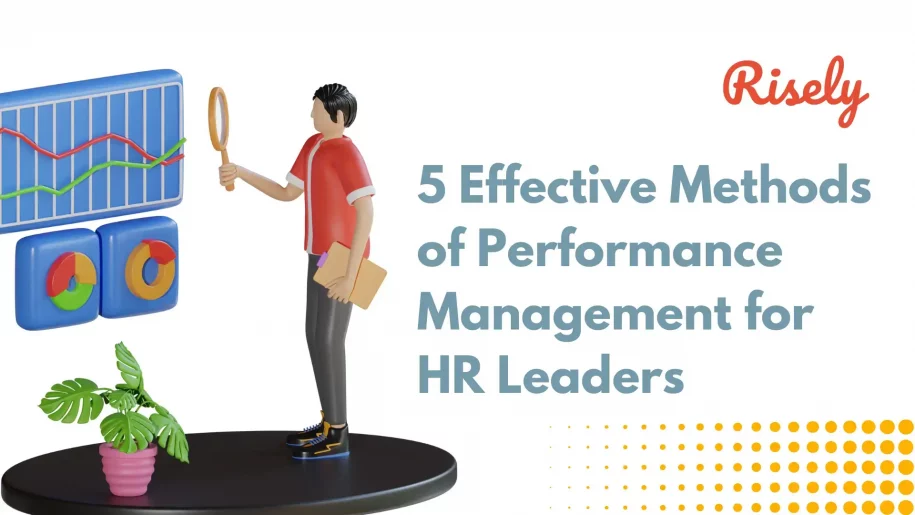5 Effective Methods of Performance Management for HR Leaders
Performance management is a crucial aspect of any organization. It continuously monitors employee performance, assesses their progress, and provides feedback to help them improve. As an HR leader, it is your responsibility to implement effective performance management strategies that can help achieve business goals. In this blog, we will discuss five effective methods of performance management that can help you achieve better results in your organization. From continuous performance feedback to coaching and mentoring programs, we will cover everything you need to know about implementing these strategies.What is Performance Management?
Performance management involves setting goals, providing feedback, and evaluating employee performance. It creates a supportive environment that encourages growth and development, ensuring employees work towards organizational objectives. By identifying training needs and offering opportunities for improvement, performance management maximizes employee potential and contributes to business success. It incorporates various methods such as appraisal, performance management system, and management by objectives (MBO). Frequent feedback and goal alignment empower employees to enhance their performance and productivity. Performance management also emphasizes the importance of teamwork, competence, and leadership skills within an organization’s culture. With its focus on continuous improvement and helpful feedback, performance management enables employees to do their best work.Five Effective Methods of Performance Management for HR Leaders
Performance Management Method 1 : Continuous Performance Feedback
Regular feedback is crucial in performance management and can significantly benefit employees and organizations. By providing continuous feedback, HR leaders can offer immediate recognition for achievements and identify areas for improvement. This open and constructive dialogue promotes transparency accountability, and fosters a culture of growth and development. It also leads to higher employee engagement and satisfaction, as employees feel their contributions are valued, and their voices are heard. Additionally, ongoing feedback ensures that performance issues are addressed promptly, allowing course correction and improvement. HR leaders can create an environment that drives employee productivity and contributes to organizational success by incorporating continuous performance feedback into their performance management system.Performance Management Method 2: Goal Setting and Alignment
Setting clear and attainable goals ensures clarity and focus, promoting a sense of purpose within the organization. Employees understand how their work contributes to the larger picture by aligning individual objectives with the overall organizational goals. Goal setting also helps prioritize tasks and effectively allocate resources, maximizing productivity and efficiency. It is a powerful motivator, inspiring employees to strive for excellence and achieve desired outcomes. Clear goals provide a roadmap for success and contribute to the organization’s overall success. By utilizing goal-setting templates and leveraging tools like performance management systems, HR leaders can facilitate goal alignment and create a culture of performance and accountability.Performance Management Method 3: Employee Development Programs
Employee development programs play a crucial role in enhancing employees’ skills, knowledge, and abilities. By providing opportunities for learning and growth, these programs contribute to the overall development of individuals within the organization. Not only do they boost employee engagement and job satisfaction, but they also play a crucial role in talent retention and succession planning. Investing in employee development leads to a skilled and competent workforce, ultimately benefiting the organization. With employee development programs in place, organizations can foster a culture of continuous improvement and create an environment that encourages employees to reach their full potential.Performance Management Method 4: Performance Metrics and KPIs
Performance metrics and key performance indicators (KPIs) are crucial in objectively measuring performance. These metrics and KPIs help track progress toward goals and targets, providing valuable insights into individual and team performance. By enabling data-driven decision-making, organizations can identify areas for improvement and make necessary adjustments to enhance efficiency and effectiveness. Performance metrics and KPIs also provide a standardized way to evaluate employee performance, allowing HR leaders to identify top performers and areas where additional support may be needed. Leveraging tools such as performance management systems, HR leaders can collect and analyze data to better understand how their organization is performing. Utilizing performance metrics and KPIs ensures that decisions are based on objective measures, leading to better overall outcomes.Performance Management Method 5: Coaching and Mentoring Programs
Coaching and mentoring programs are crucial in providing guidance and support to employees, helping them develop essential leadership and interpersonal skills. By fostering a culture of continuous learning and growth, these programs enhance employee engagement and job satisfaction and contribute to employee retention and development. The effectiveness of coaching and mentoring programs lies in their ability to provide a platform for employees to receive helpful feedback and guidance, enabling them to improve their performance. Moreover, these programs create opportunities to transfer knowledge and expertise from experienced individuals to their subordinates, ultimately benefiting the organization. With a greater focus on competence and teamwork, coaching and mentoring programs can significantly enhance the overall performance of employees and promote a positive company culture.Other Interesting Reads
How to Implement Effective Performance Management in Your Organization?
Communication and Buy-In from Leadership
Clear and effective communication is crucial for successful performance management within an organization. Managers can foster a culture of accountability and transparency by ensuring that all employees understand the goals and expectations of performance management. Leadership buy-in is also essential in creating this culture, as leaders must model the behaviors and expectations outlined in the performance management process. By obtaining buy-in from leadership, performance management is viewed as a priority throughout the organization. It promotes a greater focus on employee performance and encourages leaders to provide helpful feedback and support to their subordinates. Through clear communication and leadership buy-in, organizations can establish a performance management system that drives employee productivity and supports achieving organizational goals.Comprehensive Training for Managers and Employees
Comprehensive training programs equip managers and employees with the skills and knowledge needed for effective performance management. These training initiatives provide a thorough understanding of performance appraisal methods, goal-setting techniques, and the importance of providing helpful feedback. Managers learn how to align individual goals with organizational objectives, fostering goal alignment and creating a culture that values constant improvement. On the other hand, employees gain valuable insights into the performance management system and how it contributes to their personal and professional growth. By offering comprehensive training, organizations empower their managers and employees to excel in their roles, resulting in enhanced performance outcomes and a more productive workforce.Establishing Clear Expectations and Guidelines
Establishing clear expectations and guidelines is crucial for HR leaders to manage performance effectively. Providing employees with clarity and alignment with organizational goals fosters a sense of direction and purpose. Clear expectations outline what is expected from employees regarding their performance, behavior, and deliverables. Guidelines serve as a roadmap for employees, helping them understand the best practices and standards within the organization. This clarity reduces confusion and increases productivity. It also promotes accountability, as employees clearly understand how their performance will be evaluated. Employees can work towards a common objective by aligning individual goals with organizational goals, resulting in better performance and overall success. Establishing clear expectations and guidelines requires effective communication and documentation. HR leaders should communicate expectations through various channels, such as one-on-one meetings, team meetings, and performance appraisals. Documentation, such as job descriptions and performance management systems, helps reinforce expectations and provides a reference point for employees.Regular Performance Reviews and Evaluation
Regular performance reviews and evaluations play a vital role in effective performance management. Regular performance reviews and evaluations promote a culture of continuous improvement and accountability within the organization. It helps identify and address performance gaps, providing employees with the necessary support and resources to excel in their roles. The valuable insights gained from these assessments contribute to developing personalized employee development programs and performance improvement plans. By implementing regular performance reviews and evaluations, HR leaders can effectively manage and enhance the performance of their workforce.Conclusion
Performance management is a crucial aspect of HR leadership. By implementing effective performance management methods, HR leaders can enhance employee productivity, engagement, and overall organizational success. Continuous performance feedback allows for real-time recognition and improvement, while goal setting and alignment ensure that employees are working towards the organization’s objectives. Employee development programs promote skill growth and career advancement, and performance metrics and KPIs provide measurable indicators of success. Additionally, coaching and mentoring programs offer guidance and support to employees. To successfully implement performance management, communication and buy-in from leadership are essential. Comprehensive training for managers and employees ensures everyone understands the process and expectations. Clear expectations and guidelines help employees know what is required of them, and regular performance reviews and evaluations provide opportunities for feedback and growth. By adopting these methods and strategies, HR leaders can drive performance and create a culture of excellence within their organization.Sharpen your communication skills to make a mark with your team.
Take Risely’s free communication skills assessment now to get started toward success.
Other Related Blogs
How to build and retain high performing employees? | Laletha Nithiyanandan
How to build and retain high performing employees? | Laletha Nithiyanandan Are you really an HR if you have not spent hours chasing the ideal high performing employees for your…
How Can You Build A High Performing Culture? 7 Hacks
How Can You Build A High Performing Culture? 7 Hacks We have all heard of dream teams and tried to build them with varying levels of success and failure. Among…
10 Effective Manager Performance Goals to Drive Team Success
10 Effective Manager Performance Goals to Drive Team Success You’re sitting across from a manager in a performance review meeting. They seem unsure, disconnected from the company’s vision, and oblivious…
How to Build a High-Performing Team?
How to Build a High-Performing Team? Creating a high-performing team is a goal that every organization aspires to achieve. A high-performing team achieves superior results and can quickly adapt to…


